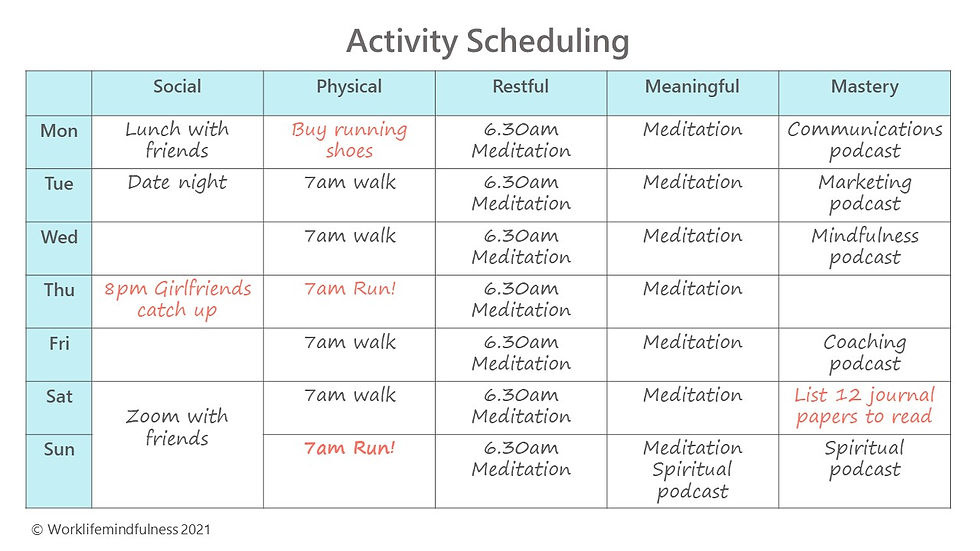Proactive mood management
- Tracey Hewett
- Aug 6, 2023
- 5 min read
Updated: Feb 21, 2024
Discover a simple way to support wellbeing and avoid burnout
Have you noticed that doing certain things can influence your mood? For example: spending time with certain people leaves you feeling drained, doing something you’ve been putting off gives you a sense of achievement whilst hearing a particular song puts a smile on your face?
What you may not have considered is purposefully doing particular things to maintain or improve your mood.
Although this may seem a little contrived (surely we should spontaneously feel happy or only do things when we feel like it?) it benefits us to regularly schedule activities that we enjoy. When we feel good, we think, work and communicate well.

Image: Nick Fewing Unsplash
Doing something that positively impacts our mood is a way to support our mental health and wellbeing and is a recognised treatment for depression (1).
It's even got a name. It's termed Behavioural Activation so called as certain behaviours can activate a positive emotional state.
Mood management and burnout
Ensuring we regularly do things that make us feel good is central to mental wealth management, the working with wellness method I developed whilst recovering from burnout.
It stems from what I came to understand was why I ended up in Burnout Hotel. Working 12-hour days with a 3-hour commute, all I could do for those 7 months was work, eat, sleep, repeat.
I simply had no time (or energy) to spend quality time with my partner, catch up with friends, exercise, walk, read, blog etc. Like we all do, I had let go of what I considered non-essential activities to meet demands.
The result?
Mental, physical and cognitive exhaustion together with a very cynical view of the workplace, my colleagues and my job.
All work and no play makes Jack a dull boy
I learned the hard way that the things we enjoy out of work aren’t just nice to do but very necessary to do.
Our hobbies and pastimes are what I call credits into our mental wealth account. They sustain, resource and ready us for the daily debits and demands that drain us.
Action! If you want to actively support your wellbeing or are concerned about burnout, use the method outlined below to identify and integrate positive mood-making activities into your life.
How to use activities to support wellbeing
This is a proven method that I use when helping someone who is seeking better work-life balance.
1. Record what you do and how you feel for a week
It's a good idea to know your starting point. You are probably already doing things that boost your mood but don't realise it, you may also be doing activities that diminish it.
During a standard working week, log what you do every hour between getting up and going to sleep and rate your emotional state during that period of time on a scale of 1-5 (1=low mood and 5=good mood). Also make a note of how you feel at the end of the day.
2. Review your week
Looking at what you recorded after seven days, what patterns can you see? Are there activities that tend to uplift and others that downshift your mood?
Can anything be changed, moved, or replaced? What do you want to keep doing or do more of?
Is your mood different the more or less activities you do?
Is there a large amount of time spent on a single activity outside of work that could be reduced or changed in some way to make time for something else that might benefit you more?
Examples:
Looking at my log, I discovered that opening email first thing when I got to work negatively impacted my mood. It put me immediately in reactive mode when I prefer to be proactive. Now the first thing I do after I switch the laptop on is read something inspiring, before planning my day, reviewing what I need to respond to immediately and what can be dealt with at a later time (and planned in diary).
I know from experience that talking to people uplifts my mood and that my brain focuses best in the morning. I decided to schedule meetings in the afternoon and rarely agree to morning ones.
When I was recovering from burnout I started each day with a walk. I continue to do this now. Walking first thing helps me ready for my day and I now see my pre-work time as mine rather than simply for household chores and getting ready for work. I have to get up earlier but it's worth it.
Having done just these two steps you will have a good idea of how what you do impacts your mood and what activities are mood positive for you.
3. List activities you fancy doing
Next jot down activities that you would like to do, do more of or begin doing again. These could be things you enjoyed when you were on holiday or things you used to do. Many of us are still not as active as we were pre-Covid19, is there anything you did before lockdown that you haven't done in awhile?
Jason Satterfield, Director of Behavioral Medicine at the University of California San Francisco, recommends what he calls a "varied diet" of activities including those that are:
physical,
social,
restful,
meaningful, and
masterful or skillful.
Tip! It helps to make the activities you wish to do specific, time-bound and measurable.
Examples:
I will read an article/journal paper concerning subject x every month (mastery/skills development).
After work, I will spend 15 minutes reflecting and listing what I have learned and/or achieved (skillful).
I will call girlfriends on Thursday evenings (social).
4. Rank them according to ease (1-3).
As much as you might like to rush right ahead diarising all these enjoyable activities you have just identified, have a think about what resources or support you might need to achieve each of them.
Are there some prior actions you need to do before you can do the activity itself? Are they realistically achievable in the next week?
Rank them 1-3 where 1 = can be completed with ease, 2 = some effort required and 3 = some difficulty involved.
Example:
I recently decided to have a go at HIIT run/walking once in the week and once on the weekend. I have never run before so will need to get some running shoes and have a training plan (I ranked this a 2). The very next step is to buy some shoes.
5. Schedule up to three new activities
Having reviewed your log of activities from the previous week how can you schedule up to three of the easiest activities you've listed into your diary next week? Now plan them into your week.

6. Do the planned activities
Here comes the moment of truth. Whether you want to or not, do the newly planned activities.
Doing something is known to change our emotional state so go ahead with your plan regardless of how you feel. Don't wait for motivation to arrive it may not show up but you can!
7. Reflect and repeat
You might want to keep another hourly log for this week or simply note how you felt when you did the scheduled and/or revised activity. How was your mood pre and post the activity? Would you like to do it again (if so when?) or try something else from your proposal list?
Bonus! As well as regularly doing things to maintain your mood, you can also use your mood positive activities to change your state when you are feeling low or in a funk.
It can take a few weeks but over time, if you persevere, you will find and create a calendar of activities that support you in feeling, thinking and doing well, as well as buffering you during stressful periods.
Take care of you.
If you would like to talk about finding ways to improve worklife balance or are feeling burned out, send me a message. Nothing changes if nothing changes.
References
1 Veale, D. (2008). Behavioural activation for depression. Advances in Psychiatric Treatment,14(1), 29-36. doi:10.1192/apt.bp.107.004051 published online 2018.



